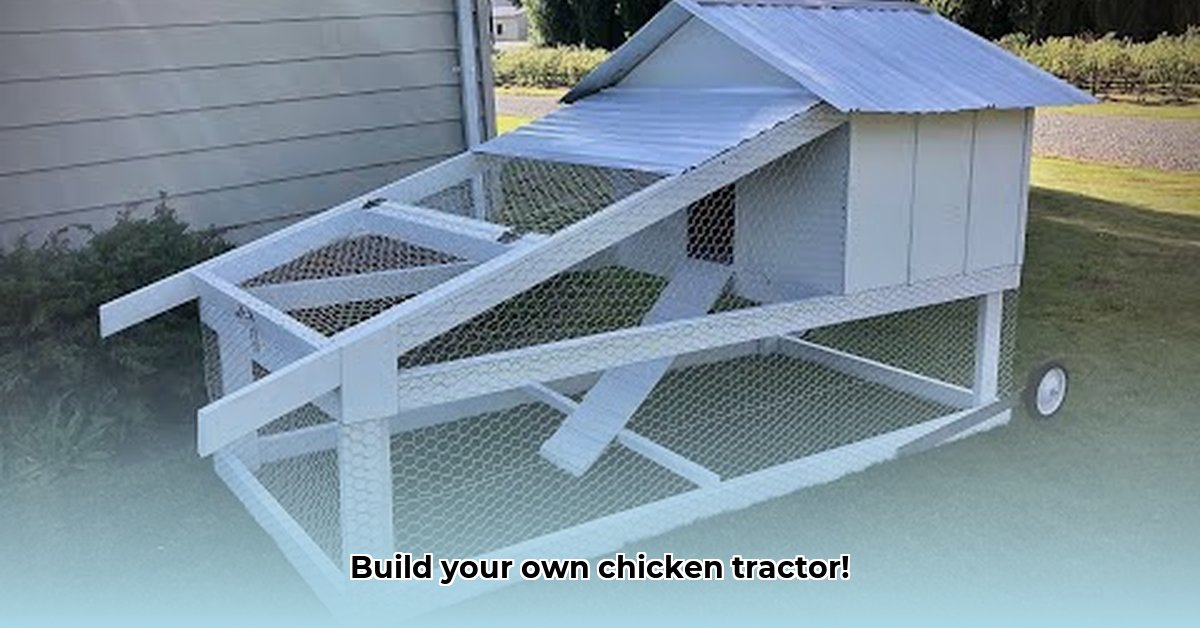
Building your own chicken tractor is a rewarding project that offers fresh eggs, improves your garden, and promotes sustainable farming practices. This guide walks you through the entire process, from planning and design to maintenance and troubleshooting. Let's build a better way to raise chickens! For more detailed plans, check out this PVC hoop house design.
Planning & Design: Laying the Foundation for Success
Before you start hammering, careful planning is crucial. Think of this as designing the perfect mobile vacation home for your feathered friends!
First, determine your flock size. A general rule is 10 square feet per hen. For five hens, you'll need at least 50 square feet inside the tractor. Next, source your materials. Reclaimed lumber offers a budget-friendly and eco-conscious option, though it may require more preparation. New lumber is easier to work with but more expensive. Finally, consider your climate. Harsh winters necessitate insulation, while hot summers demand good airflow. A simple sketch – either hand-drawn or digital – will help visualize your design. Don't underestimate the power of a good plan! Have you considered the unique challenges presented by your local climate?
Design Options: Choosing Your Chicken Tractor Style
Several basic designs provide starting points for your project, each adaptable to your needs and resources.
- The Simple Square: A straightforward design perfect for beginners, featuring four walls, a roof, and a secure access door. Think of it as a cozy chicken cabin!
- The Long and Lean: Ideal for larger flocks or wider pastures, this design promotes more efficient grazing and pasture rotation. Imagine it as a mobile chicken caravan!
Remember, these are just templates. Feel free to adapt and customize them to your vision and available space!
Material Selection: Building Blocks of Your Chicken Haven
Choosing the right materials significantly impacts the durability, cost, and aesthetics of your chicken tractor.
| Material | Pros | Cons |
|---|---|---|
| Reclaimed Lumber | Budget-friendly, sustainable, rustic aesthetic | Requires preparation (cleaning, potential repairs needed) |
| New Lumber | Consistent quality, easier to work with | More expensive |
| Metal (corrugated metal roofing) | Durable, predator-resistant, long-lasting | Can overheat in summer, more difficult to work with |
The choice depends on your budget, skill level, and climate. Combining materials can create a robust and stylish result!
Step-by-Step Construction: Building Your Mobile Chicken Coop
This process is less daunting than it seems. Prioritize safety when handling tools.
Cutting the Lumber: Accurately measure and cut your lumber according to your design plans. Precise cuts ensure a strong structure. A miter saw is helpful, but a handsaw and careful measuring will also work.
Assembling the Frame: Construct the base and walls using strong joints. Screws are generally stronger than nails, particularly for a mobile structure.
Adding the Floor: A solid floor prevents ground pecking and keeps the interior clean. Plywood offers a solid base, while wire mesh provides better ventilation. Choose the option that best suits your chickens' needs.
Attaching the Wheels: Select heavy-duty wheels capable of handling the weight of the finished tractor and its inhabitants. Consider your terrain; larger wheels are better for uneven ground.
Installing the Roof: A robust, weatherproof roof protects your birds from the elements. Metal roofing or heavy-duty plastic sheeting are excellent choices. Ensure secure attachment to resist wind and rain.
Adding the Door: A secure and easily accessible door is essential for cleaning and tending to your chickens. Use a strong latch to prevent escapes.
Predator-Proofing (Hardware Cloth): Bury hardware cloth several inches underground to deter digging predators. Ensure no gaps remain where predators could gain access.
Predator Protection: A Fortress for Your Feathered Friends
Your chicken tractor must be a safe haven. Multiple layers of defense are more effective than a single measure.
- Hardware Cloth: This heavy-duty mesh prevents small animals from entering.
- Electric Netting: An additional layer of protection particularly useful against persistent predators.
- Sturdy Construction: A robust frame resists digging or forceful entry attempts.
- Secure Doors and Latches: No weak points allowed!
- Deterrents: Shiny objects, noisy wind chimes, or even predator urine can act as deterrents.
Tailor your defenses to your specific local predators.
Pasture Management: The Mobile Feast System
Moving your chicken tractor regularly provides fresh grazing and improves soil health.
- Rotation Schedule: Move the tractor daily or every other day (depending on pasture size and flock size). This mimics how chickens would naturally forage.
- Monitoring Pasture Health: Avoid overgrazing by closely monitoring your pasture's condition.
Maintenance & Troubleshooting: Keeping Your Tractor in Tip-Top Shape
Regular maintenance is crucial. Check for loose screws or damaged parts, tightening or replacing as necessary. Clean the coop regularly to prevent waste buildup and odors that attract pests. This simple practice helps keep your chickens healthy and productive!
Conclusion: Reap the Rewards of Your DIY Chicken Tractor
Building your own chicken tractor offers numerous benefits: fresh eggs, improved soil health, and the satisfaction of a successful DIY project. Remember, this is a journey of learning and adaptation. Adjust your design and practices based on your experience and your chickens' needs. Soon, you'll be enjoying the fruits (and eggs!) of your labor!